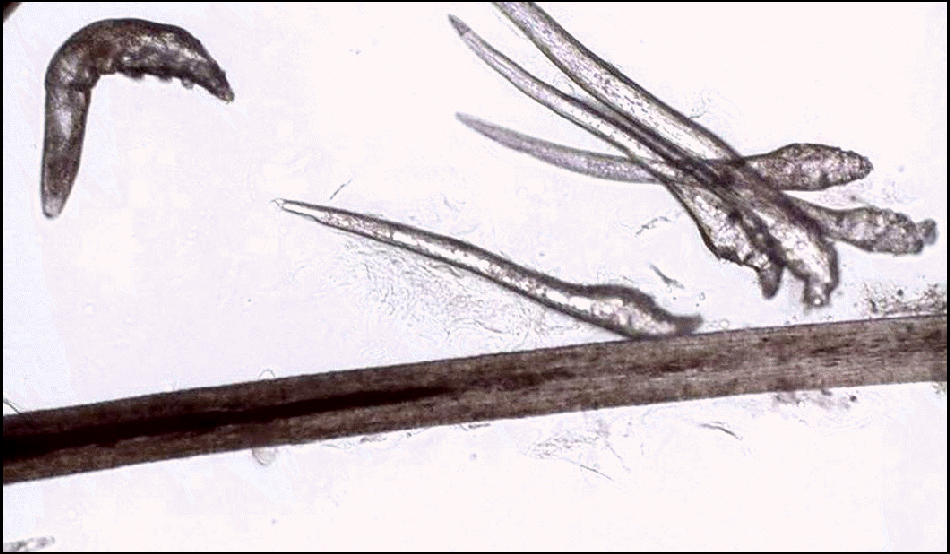Abstract
Purpose
To evaluate the treatment efficacy of polyhexamethylene biguanide (PHMB) lid scrub on Demodex blepharitis.
Methods
Thirty-one patients diagnosed with Demodex blepharitis were evaluated every 2 weeks during 8 weeks of lid scrub treatment with 0.4% PHMB. Patients underwent epilation of 4 eyelashes in each eye, and the number of Demodex lesions was counted. The patients answered questionnaires regarding ocular surface discomfort and underwent ophthalmologic exams including slit lamp and tear breakup time (TBUT). Compliance was recorded as 1 of 3 stages (good, moderate, poor).
Results
One patient was excluded for poor compliance. After PHMB lid scrub for 8 weeks, Demodex count was reduced in 28 of 30 patients (pre-PHMB 7.9 ± 3.6 counts, post-PHMB 2.2 ± 2.4 counts, p < 0.01). In addition, TBUT showed a statistically significant increase after PHMB lid scrub (pre-PHMB 2.7 ± 0.8 seconds, post-PHMB 3.4 ± 0.9 seconds, p < 0.01). Ocular surface disease index (OSDI) score was reduced in 28 of 30 patients (pre-PHMB 22.0 ± 10.7 points, post-PHMB 7.4 ± 6.0 points, p < 0.01).
Go to : 
References
1. Basta-Juzbasić A, Subić JS, Ljubojević S. Demodex folliculorum in development of dermatitis rosaceiformis steroidica and rosa-cea-related diseases. Clin Dermatol. 2002; 20:135–40.
3. Coston TO. Demodex folliculorum blepharitis. Trans Am Ophthalmol Soc. 1967; 65:361–92.
4. Karincaoglu Y, Bayram N, Aycan O, Esrefoglu M. The clinical importance of Demodex folliculorum presenting with nonspecific facial signs and symptoms. J Dermatol. 2004; 31:618–26.
5. Kamoun B, Fourati M, Feki J, et al. Blepharitis due to Demodex: myth or reality? J Fr Ophtalmol. 1999; 22:525–7.
6. Humiczewska M. Demodex folliculorum and Demodex brevis (Acarida) as the factors of chronic marginal blepharitis. Wiad Parazytol. 1991; 37:127–30.
7. Heacock CE. Clinical manifestations of demodicosis. J Am Optom Assoc. 1986; 57:914–9.
8. Lee SH, Chun YS, Kim JH, et al. The relationship between Demodex and ocular discomfort. Invest Ophthalmol Vis Sci. 2010; 51:2906–11.
9. Gao YY, Di Pascuale MA, Elizondo A, Tseng SC. Clinical treatment of ocular demodecosis by lid scrub with tea tree oil. Cornea. 2007; 26:136–43.

10. Larkin DF, Kilvington S, Dart JK. Treatment of Acanthamoeba keratitis with polyhexamethylene biguanide. Ophthalmology. 1992; 99:185–91.

11. Gao YY, Di Pascuale MA, Li W, et al. High prevalence of Demodex in eyelashes with cylindrical dandruff. Invest Ophthalmol Vis Sci. 2005; 46:3089–94.
13. Türk M, Oztürk I, Sener AG, et al. Comparison of incidence of Demodex folliculorum on the eyelash follicule in normal people and blepharitis patients. Turkiye Parazitol Derg. 2007; 31:296–7.
14. Forton F, Seys B. Density of Demodex folliculorum in rosacea: a case-control study using standardized skin-surface biopsy. Br J Dermatol. 1993; 128:650–9.

Go to : 
 | Figure 1.Photograph demonstrating ocular Demodex in Demodex blepharitis. Demodex Brevis, Demodex folliculum and eyelash observed by optical microscope (×100). |
Table 1.
Age, ocular Demodex counts, OSDI score, and TBUT with Demodex blepharitis
| Male (n = 17) | Female (n = 13) | p-value | |
|---|---|---|---|
| Age (years) | 54.0 ± 14.7 | 50.2 ± 13.7 | 0.483* |
| Demodex counts | 9.1 ± 3.5 | 7.0 ± 3.6 | 0.065* |
| TBUT (second) | 2.6 ± 0.8 | 2.8 ± 0.8 | 0.483* |
| OSDI score | 20.8 ± 11.1 | 23.6 ± 10.4 | 0.457* |
Table 2.
Demodex counts, OSDI score according to age
| Age (years) | Number | Demodex counts | OSDI score |
|---|---|---|---|
| 20-39 | 7 | 6.4 ± 1.5 | 21.1 ± 4.6 |
| 40-59 | 12 | 7.1 ± 3.5 | 21.4 ± 10.2 |
| 60< | 11 | 9.7 ± 4.2 | 23.3 ± 14.2 |
Table 3.
Demodex counts, OSDI score, and TBUT before and after PHMB treatment in Demodex blepharitis
| Pre PHMB (n = 30) | Post PHMB (n = 30) | p-value | |
|---|---|---|---|
| Demodex counts | 7.9 ± 3.6 | 2.2 ± 2.4 | <0.01* |
| TBUT (second) | 2.7 ± 0.8 | 3.4 ± 0.9 | <0.01* |
| OSDI score | 22.0 ± 10.7 | 7.4 ± 6.0 | <0.01* |
Table 4.
Demodex counts and OSDI score before, after PHMB treatment 2, 4, 8 weeks
| Before | Post PHMB (2 weeks) | Post PHMB (4 weeks) | Post PHMB (8 weeks) | |
|---|---|---|---|---|
| Demodex counts | 7.9 ± 3.6 | 5.9 ± 2.9 | 3.3 ± 2.7 | 2.2 ± 2.4 |
| OSDI score | 22.0 ± 10.7 | 19.3 ± 9.5 | 12.0 ± 8.2 | 7.4 ± 6.0 |
| p (Demodex counts) | <0.01* | <0.01* | <0.01* | |
| p (OSDI score) | 0.006* | <0.01* | <0.01* |




 PDF
PDF ePub
ePub Citation
Citation Print
Print


 XML Download
XML Download